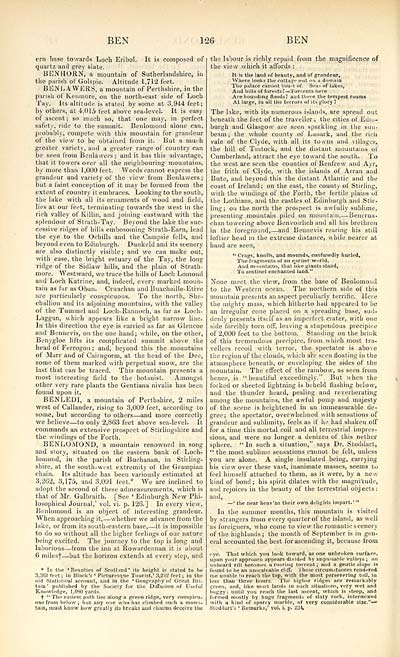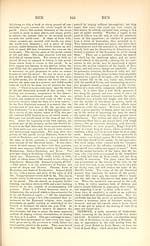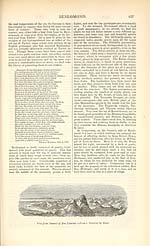Topographical, statistical, and historical gazetteer of Scotland > Volume 1
(206) Page 126
Download files
Complete book:
Individual page:
Thumbnail gallery: Grid view | List view

BEN
126
BEN
em base towards Loch Eribol. It is composed of
quartz and prey slate.
BEN HORN, a mountain of Sutherlandshire, in
tbe parish' of Golspie. Altitude 1,712 feet.
BENLAWERS, a mountain of Perthshire, in the
parish of Kenmore, on the north-east side of Loch
Tay. Its altitude is stated by some at 3,944 feet;
by others, at 4,015 feet above sea-level. It is easy
of ascent; so much so, that one may, in perfect
safety, ride to the summit. Benlomond alone can,
probably, compete with this mountain for grandeur
of the view to be obtained from it. But a much
greater variety, and a greater range of country can
be seen from Benlawers ; and it has this advantage,
that it towers over all the neighbouring mountains,
by more than 1,000 feet. Words cannot express the
grandeur and variety of the view from Benlawers ;
but a faint conception of it may be formed from the
extent of country it embraces. Looking to the south,
the lake with all its ornaments of wood and field,
lies at our feet, terminating towards the west in the
rich valley of Killin, and joining eastward with the
splendour of Strath-Tay. Beyond the lake the suc-
cessive ridges of hills embosoming Strath-Earn, lead
the eye to the Ochills and the Campsie fells, and
beyond even to Edinburgh. Dunkeld and its scenery
are also distinctly visible ; and we can make out,
with ease, the bright estuary of the Tay, the long
ridge of the Sidlaw hills, and the plain of Strath-
more. Westward, we trace the hills of Loch Lomond
and Loch Katrine, and, indeed, every marked moun-
tain as far as Oban. Cruachan and Buachaille-Etive
are particularly conspicuous. To the north, She-
challion and its adjoining mountains, with the valley
of the Tummel and Loch-Rannoch, as far as Loch-
Laggan, which appears like a bright narrow line.
In this direction the eye is carried as far as Glencoe
and Bennevis, on the one hand; while, on the other,
Benygloe lifts its complicated summit above the
head of Ferrogon ; and, beyond this the mountains
of Marr and of Cairngorm, at the head of the Dee,
some of them marked with perpetual snow, are the
last that can be traced. This mountain presents a
most interesting field to the botanist. Amongst
other very rare plants the Gentiana nivalis has been
found upon it.
BENLEDI, a mountain of Perthshire, 2 miles
west of Callander, rising to 3,009 feet, according to
some, but according to others — and more correctly
we believe — to only 2,863 feet above sea-level. It
commands an extensive prospect of Stirlingshire and
the windings of the Forth.
BENLOMOND, a mountain renowned in song
and story, situated on the eastern bank of Loch-
lomond, in the parish of Buchanan, in Stirling-
shire, at the south-west extremity of the Grampian
chain. Its altitude has been variously estimated at
3,262, 3,175, and 3,091 feet.* We are inclined to
adopt the second of these admeasurements, which is
that of Mr. Galbraith. [See ' Edinburgh New Phi-
losophical Journal,' vol. vi. p. 126.] In every view,
Benlomond is an object of interesting grandeur.
When approaching it, — whether we advance from the
lake, or from its south-eastern base, — it is impossible
to do so without all the higher feelings of our nature
being excited. The journey to the top is long and
laborious — from the inn at Rowardennan it is about
6 milesf — but the horizon extends at every step, and
* In the 'Beailt.ies of Scotland' its height is stated to be
3.3G2 feet; in Black's ' Picturesque Tourist,' 3,212 feet; in tile
old Statistical account, and in the ' Geography of Great Bri-
tain' published by the Society for the Diffusion of Useful
Knowledge, 1,030 yards.
f "The easiest path lies along; a green ridge, very conspicu-
ous from beluw; but any one who has climbed Buch a moun-
tain, must kuow how greatly its breaks and chasms deceive tile
the labour is richly repaid from the magnificence of
the view which it affords :
It is tbe land of beauty, and of grandeur,
Where looks the cottage out on a domain
The palace cannot boast of. Seas of lakes,
And hills of forests I— Torrents here
Are bounding floods! and there the tempest roams
At large, in all the terrors of its glory !
The lake, with its numerous islands, are spread out
beneath the feet of the traveller; the cities of Edin-
burgh and Glasgow are seen sparkling in the sun-
beam ; the whole county of Lanark, and the rich
vale of the Clyde, with all its towns and villages,
the hill of Tmtock, and the distant mountains of
Cumberland, attract the eye toward the south. To
the west are seen the counties of Renfrew and Ayr,
the frith of Clyde, with the islands of Arran and
Bute, and beyond this the distant Atlantic and the
coast of Ireland; on the east, the county of Stirling,
with the windings of the Forth, the fertile plains of
the Lothians, and the castles of Edinburgh and Stir-
ling; on the north the prospect is awfully sublime,
presenting mountain piled on mountain, — Bencrua-
chan towering above Benvoirlich and all his brethren
in the foreground, — and Bennevis rearing his still
loftier head in the extreme distance, while nearer at
hand are seen,
*' Crags, knolls, and mounds, confusedly hurled,
The fragments of an e_arlier world,
And mountains, that Tike giants stand,
To sentinel enchanted land."
None meet the view, from the base of Benlomond
to the Western ocean. The northern side of this
mountain presents an aspect peculiarly terrific. Here
the mighty mass, which hitherto had appeared to be
an irregular cone placed on a spreading base, sud-
denly presents itself as an imperfect crater, with one
side forcibly torn off, leaving a stupendous precipice
of 2,000 feet to the bottom. Standing on the brink
of this tremendous precipice, from which most tra-
vellers recoil with terror, the spectator is above
the region of the clouds, which ate seen floating in the
atmosphere beneath, or enveloping the sides of the
mountain. The effect of the rainbow, as seen from
bence, is " beautiful exceedingly." But when the
forked or sheeted lightning is beheld flashing below,
and the thunder heard, pealing and reverberating
among the mountains, the awful pomp and majesty
of the scene is heightened in an immeasurable de-
gree; the spectator, overwhelmed with sensations of
grandeur and sublimity, feels as if he had shaken off
for a time this mortal coil and all terrestrial impres-
sions, and were no longer a denizen of this nether
sphere. " In such a situation," says Dr. Stoddart,
" the most sublime sensations cannot be felt, unless
you are alone. A single insulated being, carrying
his view over these vast, inanimate masses, seems to
feel himself attached to them, as it were, by a new
kind of bond; his spirit dilates with the magnitude,
and rejoices in the beauty of the terrestrial objects:
and,
— ' the near heav'ns their own delights impart.' "
In the summer months, this mountain is visited
by strangers from every quarter of the island, as well
as foreigners, who come to view the romantic scenery
of the highlands; the month of September is in gen-
eral accounted the best for ascending it, because from
eye. That which you look toward, as one unbroken surface,
upon your approach appears divided by impassable valleys; an
unheard rill becomes a roaring torrent; and a gentle slope is
found to be an unscaleable cliff. These circumstances rendered
roe unable to reach the top, with the most persevering toil, in
less than three hours. The higher ridges are remarkably
green, and, like most lands in such situations, very wet and
boggy; until you reach the laHt ascent, which is steep, and
formed mostly by hugti fragments of slaty rock, intermixed
with a kind of sparry marble, of very considerable size."-*'
Stoddart's ' Remarks,' vol. i. p. 23i»
126
BEN
em base towards Loch Eribol. It is composed of
quartz and prey slate.
BEN HORN, a mountain of Sutherlandshire, in
tbe parish' of Golspie. Altitude 1,712 feet.
BENLAWERS, a mountain of Perthshire, in the
parish of Kenmore, on the north-east side of Loch
Tay. Its altitude is stated by some at 3,944 feet;
by others, at 4,015 feet above sea-level. It is easy
of ascent; so much so, that one may, in perfect
safety, ride to the summit. Benlomond alone can,
probably, compete with this mountain for grandeur
of the view to be obtained from it. But a much
greater variety, and a greater range of country can
be seen from Benlawers ; and it has this advantage,
that it towers over all the neighbouring mountains,
by more than 1,000 feet. Words cannot express the
grandeur and variety of the view from Benlawers ;
but a faint conception of it may be formed from the
extent of country it embraces. Looking to the south,
the lake with all its ornaments of wood and field,
lies at our feet, terminating towards the west in the
rich valley of Killin, and joining eastward with the
splendour of Strath-Tay. Beyond the lake the suc-
cessive ridges of hills embosoming Strath-Earn, lead
the eye to the Ochills and the Campsie fells, and
beyond even to Edinburgh. Dunkeld and its scenery
are also distinctly visible ; and we can make out,
with ease, the bright estuary of the Tay, the long
ridge of the Sidlaw hills, and the plain of Strath-
more. Westward, we trace the hills of Loch Lomond
and Loch Katrine, and, indeed, every marked moun-
tain as far as Oban. Cruachan and Buachaille-Etive
are particularly conspicuous. To the north, She-
challion and its adjoining mountains, with the valley
of the Tummel and Loch-Rannoch, as far as Loch-
Laggan, which appears like a bright narrow line.
In this direction the eye is carried as far as Glencoe
and Bennevis, on the one hand; while, on the other,
Benygloe lifts its complicated summit above the
head of Ferrogon ; and, beyond this the mountains
of Marr and of Cairngorm, at the head of the Dee,
some of them marked with perpetual snow, are the
last that can be traced. This mountain presents a
most interesting field to the botanist. Amongst
other very rare plants the Gentiana nivalis has been
found upon it.
BENLEDI, a mountain of Perthshire, 2 miles
west of Callander, rising to 3,009 feet, according to
some, but according to others — and more correctly
we believe — to only 2,863 feet above sea-level. It
commands an extensive prospect of Stirlingshire and
the windings of the Forth.
BENLOMOND, a mountain renowned in song
and story, situated on the eastern bank of Loch-
lomond, in the parish of Buchanan, in Stirling-
shire, at the south-west extremity of the Grampian
chain. Its altitude has been variously estimated at
3,262, 3,175, and 3,091 feet.* We are inclined to
adopt the second of these admeasurements, which is
that of Mr. Galbraith. [See ' Edinburgh New Phi-
losophical Journal,' vol. vi. p. 126.] In every view,
Benlomond is an object of interesting grandeur.
When approaching it, — whether we advance from the
lake, or from its south-eastern base, — it is impossible
to do so without all the higher feelings of our nature
being excited. The journey to the top is long and
laborious — from the inn at Rowardennan it is about
6 milesf — but the horizon extends at every step, and
* In the 'Beailt.ies of Scotland' its height is stated to be
3.3G2 feet; in Black's ' Picturesque Tourist,' 3,212 feet; in tile
old Statistical account, and in the ' Geography of Great Bri-
tain' published by the Society for the Diffusion of Useful
Knowledge, 1,030 yards.
f "The easiest path lies along; a green ridge, very conspicu-
ous from beluw; but any one who has climbed Buch a moun-
tain, must kuow how greatly its breaks and chasms deceive tile
the labour is richly repaid from the magnificence of
the view which it affords :
It is tbe land of beauty, and of grandeur,
Where looks the cottage out on a domain
The palace cannot boast of. Seas of lakes,
And hills of forests I— Torrents here
Are bounding floods! and there the tempest roams
At large, in all the terrors of its glory !
The lake, with its numerous islands, are spread out
beneath the feet of the traveller; the cities of Edin-
burgh and Glasgow are seen sparkling in the sun-
beam ; the whole county of Lanark, and the rich
vale of the Clyde, with all its towns and villages,
the hill of Tmtock, and the distant mountains of
Cumberland, attract the eye toward the south. To
the west are seen the counties of Renfrew and Ayr,
the frith of Clyde, with the islands of Arran and
Bute, and beyond this the distant Atlantic and the
coast of Ireland; on the east, the county of Stirling,
with the windings of the Forth, the fertile plains of
the Lothians, and the castles of Edinburgh and Stir-
ling; on the north the prospect is awfully sublime,
presenting mountain piled on mountain, — Bencrua-
chan towering above Benvoirlich and all his brethren
in the foreground, — and Bennevis rearing his still
loftier head in the extreme distance, while nearer at
hand are seen,
*' Crags, knolls, and mounds, confusedly hurled,
The fragments of an e_arlier world,
And mountains, that Tike giants stand,
To sentinel enchanted land."
None meet the view, from the base of Benlomond
to the Western ocean. The northern side of this
mountain presents an aspect peculiarly terrific. Here
the mighty mass, which hitherto had appeared to be
an irregular cone placed on a spreading base, sud-
denly presents itself as an imperfect crater, with one
side forcibly torn off, leaving a stupendous precipice
of 2,000 feet to the bottom. Standing on the brink
of this tremendous precipice, from which most tra-
vellers recoil with terror, the spectator is above
the region of the clouds, which ate seen floating in the
atmosphere beneath, or enveloping the sides of the
mountain. The effect of the rainbow, as seen from
bence, is " beautiful exceedingly." But when the
forked or sheeted lightning is beheld flashing below,
and the thunder heard, pealing and reverberating
among the mountains, the awful pomp and majesty
of the scene is heightened in an immeasurable de-
gree; the spectator, overwhelmed with sensations of
grandeur and sublimity, feels as if he had shaken off
for a time this mortal coil and all terrestrial impres-
sions, and were no longer a denizen of this nether
sphere. " In such a situation," says Dr. Stoddart,
" the most sublime sensations cannot be felt, unless
you are alone. A single insulated being, carrying
his view over these vast, inanimate masses, seems to
feel himself attached to them, as it were, by a new
kind of bond; his spirit dilates with the magnitude,
and rejoices in the beauty of the terrestrial objects:
and,
— ' the near heav'ns their own delights impart.' "
In the summer months, this mountain is visited
by strangers from every quarter of the island, as well
as foreigners, who come to view the romantic scenery
of the highlands; the month of September is in gen-
eral accounted the best for ascending it, because from
eye. That which you look toward, as one unbroken surface,
upon your approach appears divided by impassable valleys; an
unheard rill becomes a roaring torrent; and a gentle slope is
found to be an unscaleable cliff. These circumstances rendered
roe unable to reach the top, with the most persevering toil, in
less than three hours. The higher ridges are remarkably
green, and, like most lands in such situations, very wet and
boggy; until you reach the laHt ascent, which is steep, and
formed mostly by hugti fragments of slaty rock, intermixed
with a kind of sparry marble, of very considerable size."-*'
Stoddart's ' Remarks,' vol. i. p. 23i»
Set display mode to: Large image | Transcription
Images and transcriptions on this page, including medium image downloads, may be used under the Creative Commons Attribution 4.0 International Licence unless otherwise stated. ![]()
| Gazetteers of Scotland, 1803-1901 > Topographical, statistical, and historical gazetteer of Scotland > Volume 1 > (206) Page 126 |
|---|
| Permanent URL | https://digital.nls.uk/97440018 |
|---|
| Description | Volume first. A-H. |
|---|---|
| Attribution and copyright: |
|

